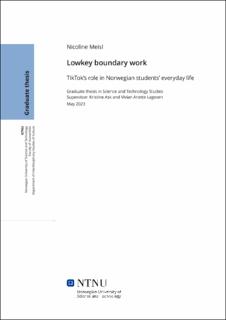| dc.contributor.advisor | Ask, Kristine | |
| dc.contributor.advisor | Lagesen, Vivian Anette | |
| dc.contributor.author | Meisl, Nicoline | |
| dc.date.accessioned | 2023-09-05T17:19:59Z | |
| dc.date.available | 2023-09-05T17:19:59Z | |
| dc.date.issued | 2023 | |
| dc.identifier | no.ntnu:inspera:143154431:52621130 | |
| dc.identifier.uri | https://hdl.handle.net/11250/3087627 | |
| dc.description.abstract | Som nyeste tillegg til sosiale medieplattformer, sikter TikTok mot å inspirere glede og kreativitet i brukerne. Plattformen er basert på kortformede mobilvideoer og ønsker at brukere skal delta ved å se, like, kommentere og publisere innhold. Med sin unike feed tilpasset den individuelle brukeren tiltrekker og underholder TikTok alle typer brukere. Mellom 2019 og 2020 har TikTok vokst enormt og blitt en av de mest populære sosiale medieplattformene i Norge, spesielt blant unge voksne. I denne masteroppgaven undersøker jeg hvordan norske studenter forstår og bruker plattformen. Mitt fokus ligger på undersøkelsen av hvordan TikTok blir en del av studentenes hverdag. Oppgaven belyser teknologibruk fra et brukerperspektiv og er basert på 11 kvalitative intervjuer med norske studenter. Det teoretiske rammeverket består av domestiseringsteori fra STS-feltet, i tillegg til begreper om digital detox og algoritmer.
For å forstå hvordan studenter domestiserte TikTok, undersøker jeg hvordan student identitet spiller inn i teknologibruken og fant ut at dette ikke er en relevant del av deres bruk av plattformen. For å bedre forstå teknologibruk ser jeg på hvordan de ulike forståelser og fortolkninger av TikTok fører til ulike brukermønstre og vaner. Her identifiserte jeg fem brukertyper som fremhever allsidigheten ved teknologibruk. Gjennom denne prosessen oppdaget jeg at tidsaspektet og plattformens algoritme formet deltakernes bruk av TikTok. Derfor beskriver jeg strategier deltakerne benytter seg av i sine forhandlinger om tids brukt på plattformen og hvordan samfunnsnormer knyttet til dette former deres bruk. Til slutt illustrerer jeg strategier deltakerne brukte for å påvirke og forstå TikTok algortimen og å tilpasse feeden deres. | |
| dc.description.abstract | As one of the newest additions to social media platforms, TikTok means to inspire joy and creativity in their users. The platform wants users to engage with its short-form mobile videos by viewing, liking, commenting, and publishing content. With its unique feed customized to the individual user TikTok attracts and entertains all kinds of users. Between 2019 and 2020 TikTok has grown tremendously and become one of the most popular social media platforms in Norway, especially amongst young adults. In this master thesis I examine how Norwegian students understand and use the platform. My focus lies on investigating how TikTok becomes a part of students’ everyday lives. The thesis approaches the topic of technology use from a user perspective and is based on 11 qualitative interviews with Norwegian students. The theoretical framework consists of domestication theory from the field of STS, in addition to concepts about digital detox and algorithms.
To understand how students domesticated TikTok, I investigate how student identity played into the technology use and found that student identity is not relevant in their use of the platform. To better understand technology use, I look at how the different understandings and interpretations of TikTok lead to various user patterns and habits. Here I identified five user types that highlight the versatility of technology use. Throughout this process I observed that the aspect of time and the platforms algorithm shaped the participants use of TikTok. Therefore, I describe strategies the participants make use of in their negotiations of time spent on the platform and how societal norms connected to this shape their use. Lastly, I illustrate strategies the participants made use of to influence and make sense of the TikTok algorithm and personalize their feed. | |
| dc.language | eng | |
| dc.publisher | NTNU | |
| dc.title | Lowkey boundary work - TikTok’s role in Norwegian students’ everyday life | |
| dc.type | Master thesis | |
